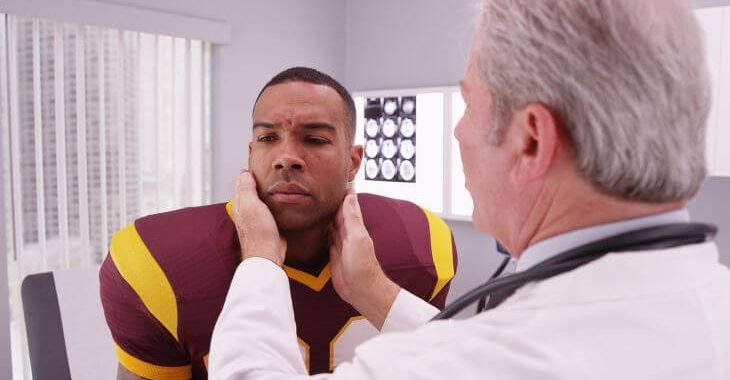Cauliflower Ear Surgery and Treatments

Have you seen ears that are deformed with lumps and bumps? Commonly called cauliflower ear, perichondrial hematoma is a condition caused by trauma to the ear. This malformation is common among wrestlers, boxers, MMA participants and any other types of contact sport athletes. Here is what you need to know about what causes cauliflower ear, prevention and cauliflower ear treatments.
What Causes Cauliflower Ear?
Perichondrial hematoma occurs when the pinna, the outer portion of the ear, is injured by blunt trauma. The pinna is made mostly of cartilage, which has very few blood vessels, but still needs blood flow to provide it with nutrients to stay healthy. The perichondrium is the fibrous tissue that surrounds the pinna cartilage, which is vital to transmitting nutrients from the small blood vessels in the ear to the cartilage. Trauma to the ear can tear or damage the blood vessels, causing a hematoma or pooling of blood between the perichondrium and cartilage in the ear.
When a perichondrial hematoma occurs, it can result in the pinna, or ear cartilage, losing access to nutrients from the blood. Without the oxygen and nutrients that it needs, the cartilage can deteriorate. The cartilage can become infected and cartilage cells can begin to die. If not treated immediately, fibrous scar tissue can form in the ear, creating the bumpy appearance that is common with cauliflower ear. In addition, a perichondrial hematoma can result in headaches, tinnitus, blurred vision and hearing loss. It is important to know how to prevent and treat cauliflower ear to avoid permanent damage or injury.
Prevention of Perichondrial Hematomas
Protecting the ear from trauma is the best way to prevent cauliflower ear. Wearing ear protectors or a helmet when participating in contact sports is recommended for preventing ear and head injuries. This is especially important for young athletes that can be prone to ear damage. Individuals who are taking blood thinners are at higher risk for perichondrial hematomas – it is vital to wear a helmet to protect the ears if playing contact sports and using blood thinners.
Cauliflower Ear Treatment
Not all perichondrial hematomas can be prevented. Ear trauma can occur from all types of accidents, including falls and vehicle crashes, as well as sports. Early treatment can minimize the risk of damage to the ear, both inside and outside. If there is a blow the side of the head or ear, watch for signs of blood pooling. This can include bruising, discoloration or swelling of the outer ear. Early cauliflower ear treatment includes placing an ice pack on the ear in 15-minute intervals and seeking medical attention.
For a severe perichondrial hematoma, a physician will want to drain the pooling blood from the ear. An incision at the site of the hematoma can allow the blood to drain and restore normal blood flow to the ear cartilage. To reduce the chance of a new hematoma forming, a compression dressing may be wrapped around the head and ear. It is important to continue wearing the compression dressing until the ear begins to heal, and to follow physician recommendations regarding avoiding activities that can cause additional ear trauma.
Unfortunately, if early cauliflower ear treatment is not performed, or the treatment is not effective, the ear may still become deformed. Many times, ear trauma is overlooked and left untreated, allowing a perichondrial hematoma to cause damage to the ear. If the scar tissue forms in the ear, the effects are permanent. The bumpy ear appearance that looks like a cluster of cauliflower can be a distracting and unwelcome feature. The only option for restoring a normal appearance to the ear is with cosmetic cauliflower ear surgery performed by a plastic surgeon.

Cosmetic Cauliflower Ear Surgery
Cauliflower ear can impact appearance and self-confidence. Many people with this ear deformity try to hide their ears under their hair or a hat, but the best permanent solution is plastic surgery. A talented plastic surgeon can perform ear shaping, or otoplasty, to remove scar tissue and reshape the pinna of the ear.
Cosmetic cauliflower ear surgery requires that the excess fibrous scar tissue be removed and the ear reshaped. The incision can be made behind the ear, hiding it from view, allowing access to the ear to remove tissue and reshape the pinna. In severe cases, cartilage may need to be replaced to create the desired shape. This can require a cartilage graft, usually harvesting cartilage from the patient’s rib bones to graft into the ear.
Cauliflower ear is an unfortunate consequence of trauma to the ear that is left untreated. Prevention and early cauliflower ear treatment are the best ways to avoid this ear deformity. For those with cauliflower ear, surgery is the only option to restore a smooth, natural appearance to the ear. Contact an experienced plastic surgeon who offers otoplasty to reshape and fix a cauliflower ear deformity.
The information provided on this website, including text, graphics, images, and other materials, is intended solely for informational purposes and should not be used as a substitute for professional medical advice, diagnosis, or treatment.



)